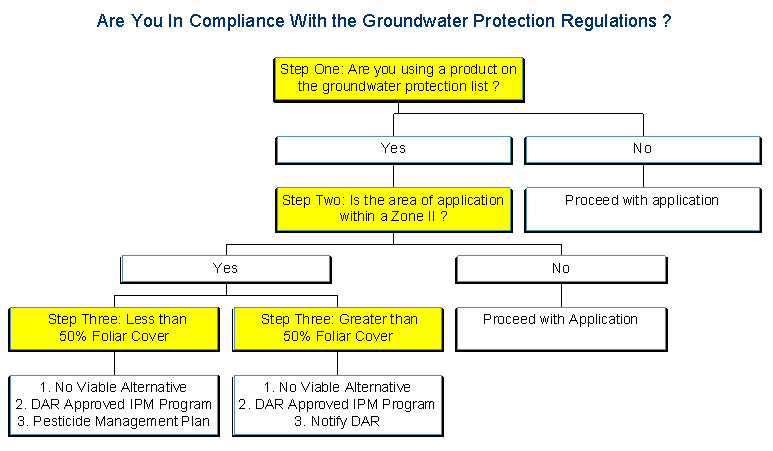The Department’s Groundwater Protection Regulations are intended to prevent contamination of public drinking water supply wells through regulating the application of pesticide products on the Groundwater Protection List within primary recharge areas. A primary recharge area is either an “Interim Wellhead Protection Area” or a “Zone II. ” The following step-by-step approach should enable applicators to determine if they need to comply with the regulations.
- This page, How do I Comply with Groundwater Protection Regulations?, is offered by
- Massachusetts Department of Agricultural Resources
- Pesticide Program
Table of Contents
Groundwater Protection Compliance Flow Chart
Step One: Check the Groundwater Protection List of Active Ingredients
The groundwater protection regulations apply only to pesticides which are on the Groundwater Protection List. The list is maintained on the Department of Agricultural Resources website. If the active ingredient is listed, the applicator must then establish if the pesticide application is to be made in a regulated primary recharge area
Step Two: Are you applying a product within a regulated area ?
The pesticide groundwater protection regulations ONLY apply to regulated primary recharge areas designated as a Zone II or an Interim Wellhead Protection Area (IWPA) by the Massachusetts Department of Environmental Protection (MassDEP). To establish if you are in a regulated primary recharge area, you will need to follow the approach outlined in the following section:
How to Establish The Location of a Regulated Primary Recharge Area- Zone II or IWPA
A. Check to see if the area where the application is to be made is located in a regulated wellhead protection area. The MassMapper allows viewing of a detailed map of regulated primary recharge areas (Zone II's or Interim Wellhead Protection Areas (IWPAs).
B. Traditional Options
If you do not have Internet access:
- Check with the local water department for a Source Water Assessment Plan (SWAP) map which will show all Zone IIs.
- Check with the local Board of Health for the Title 5 maps which were updated in 2003
- Check with the regional DEP office:
- DEP Western Regional Office, 413-784-110
- DEP Central Regional Office 508-792-7650
- DEP Southeast Regional Office 508-946-2700
If your area of application is located with the primary recharge area, you must determine if you are applying to an area with less than 50% foliar ground cover or greater than 50% foliar ground cover. Proceed to Step 3.
Step Three: Are you applying pesticides in an area which has greater or less than a 50% foliar cover ?
To apply a pesticide which is listed on the groundwater protection list within a Zone II or IWPA (which is permitted to pump greater than 100,000gpd) the applicator must distinguish between the following application scenarios and decide which scenario best applies :
A. For a pesticide product which is applied to an area which has greater than 50% foliar ground cover the applicator must ensure that:
- there is no viable alternative to the use of the pesticide, and
- the pesticide is being applied as part of an Integrated Pest Management (IPM) program from Department approved sources, and
- the Department of Agricultural Resources is notified of any applications of a product on the groundwater protection list within ten days of the end of the calendar month in which the pesticide is applied.
B. For a pesticide product which is soil applied or applied to an area with less than 50% foliar ground cover the applicator must ensure that:
- there is no viable alternative to the use of the pesticide, and
- the pesticide is being applied as part of an Integrated Pest Management (IPM) program from Department approved sources, and
- a Pesticide Management Plan (PMP) for that use pattern has been approved by the Department of Agricultural Resources.
